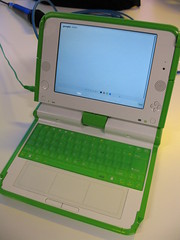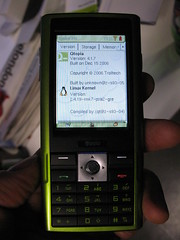The Null Device
2007/3/16
Proof that the wowsers haven't completely won the Australian culture war: Australian commercial radio stations have received complaints for playing censored American radio edits of alternative-rock/rap songs:
Nova 100 music director Estelle Paterson said the station received complaints about "radio edited" or "clean" songs it played, describing a version provided by record companies which is shorter and deletes profanity present on album versions.
Radio edits of some hip-hop songs are so cut-up as to be almost unusable, she added, laughing, "And in America everything's considered offensive!"
Scientists have developed a drug capable of erasing individual, specific memories. The memory erasure procedure is carried out by administering the drug and then restimulating the memory.
To find out, they trained rats to fear two different musical tones, by playing them at the same time as giving the rats an electric shock. Then, they gave half the rats a drug known to cause limited amnesia (U0126, which is not approved for use in people), and reminded all the animals, half of which were still under the influence of the drug, of one of their fearful memories by replaying just one of the tones. When they tested the rats with both tones a day later, untreated animals were still fearful of both sounds, as if they expected a shock. But those treated with the drug were no longer afraid of the tone they had been reminded of under treatment.Before you book yourself in to do something about your unrequited crushes and/or traumatic childhood experiences, note that the procedure only works on memories that have yet to have been transferred from short-term to long-term memory. And it's not approved for use on humans.
In Oslo, Norway, some concerned citizen has taken it upon themselves to cover up indecently unclothed statues:
With the exception of one lone figure, every scrap of nipple, crotch or posterior was covered with black strips of paper, no matter the size nor position of the statue. The unknown assailant left an explanatory note behind: "There is too much nudity in newspapers and magazines, so here on the bridge the limit has been reached!"
(via Boing Boing) ¶ 0
Last night, I went to the London Open Source Jam, a Linux-themed show-and-tell hosted at the Google offices near Victoria Station.
They had various speakers who came in, bringing in variously interesting Linux-based projects, talking (very) briefly about them and then letting people poke around with them.
 They had some people from the One Laptop Per Child project, who brought along two prototypes of the US$100 laptops which they are going to build and distribute to children in the developing world. The machines are very well designed (they're full of innovative design features, they're reportedly almost indestructable, and they look desirably good); they're based on Linux and Python, look nothing like the machines used elsewhere, and are designed to encourage tinkering and exploration. They even have a key (labelled with a graphic of a cog) which, when pressed, takes you to the source code for the currently running program so you can hack and modify it. (That didn't seem to be working on the laptop I looked at, though that prototype wasn't working perfectly.)
They had some people from the One Laptop Per Child project, who brought along two prototypes of the US$100 laptops which they are going to build and distribute to children in the developing world. The machines are very well designed (they're full of innovative design features, they're reportedly almost indestructable, and they look desirably good); they're based on Linux and Python, look nothing like the machines used elsewhere, and are designed to encourage tinkering and exploration. They even have a key (labelled with a graphic of a cog) which, when pressed, takes you to the source code for the currently running program so you can hack and modify it. (That didn't seem to be working on the laptop I looked at, though that prototype wasn't working perfectly.)
 Someone also brought along a Trolltech Greenphone; that's a new mobile phone, created by Trolltech (the Norwegian company that makes the Qt toolkit (a rather elegant GUI library) and the Qtopia interface for portable devices), and based entirely on open-source(ish) software. It looked much like a regular phone, albeit with some developer features. I saw no evidence of it containing WiFi, though, so it may be lacking in that department.
Someone also brought along a Trolltech Greenphone; that's a new mobile phone, created by Trolltech (the Norwegian company that makes the Qt toolkit (a rather elegant GUI library) and the Qtopia interface for portable devices), and based entirely on open-source(ish) software. It looked much like a regular phone, albeit with some developer features. I saw no evidence of it containing WiFi, though, so it may be lacking in that department.
Sony sent along a representative with a PS3 console, to show that it could boot Linux (and not only from special Sony-approved distributions, as the PS2 could, but from any distribution of your choice). Of course, the catch is that when the PS3 boots an untrusted Linux disc of your own providing, it runs it in a sandbox (under a Xen-style hypervisor), isolating it completely from the nifty graphics chip (so that game developers can't evade Sony's game-licensing fees by distributing full-featured games as bootable Linux live DVDs), and reducing it to a generic computer with a somewhat unusual CPU.
 They had a demo, which rendered a Mandelbrot set and let you zoom around on it; it was like a faster version of something I saw on a 386 PC in 1989. All in all, I found this demo underwhelming; when asked why anyone would want to run Linux in a sandbox on a PS3 when one could build a PC for less and get access to better graphics capabilities, the Sony rep didn't have a good answer; it was intended, she said, for people who already have a PS3 and, for some reason, are seized with the desire to run Linux on it. Though I suspect that, the fact that doing so doesn't involve breaking locks or using the hardware for anything more than it was designed for (the fact that the PS3 can be a mediocre Linux box is about as exciting as the fact that an iPod can be a mediocre PDA, or a mobile phone can be a mediocre MP3 player), will largely leach any such endeavour of any hack value it may have had.
They had a demo, which rendered a Mandelbrot set and let you zoom around on it; it was like a faster version of something I saw on a 386 PC in 1989. All in all, I found this demo underwhelming; when asked why anyone would want to run Linux in a sandbox on a PS3 when one could build a PC for less and get access to better graphics capabilities, the Sony rep didn't have a good answer; it was intended, she said, for people who already have a PS3 and, for some reason, are seized with the desire to run Linux on it. Though I suspect that, the fact that doing so doesn't involve breaking locks or using the hardware for anything more than it was designed for (the fact that the PS3 can be a mediocre Linux box is about as exciting as the fact that an iPod can be a mediocre PDA, or a mobile phone can be a mediocre MP3 player), will largely leach any such endeavour of any hack value it may have had.